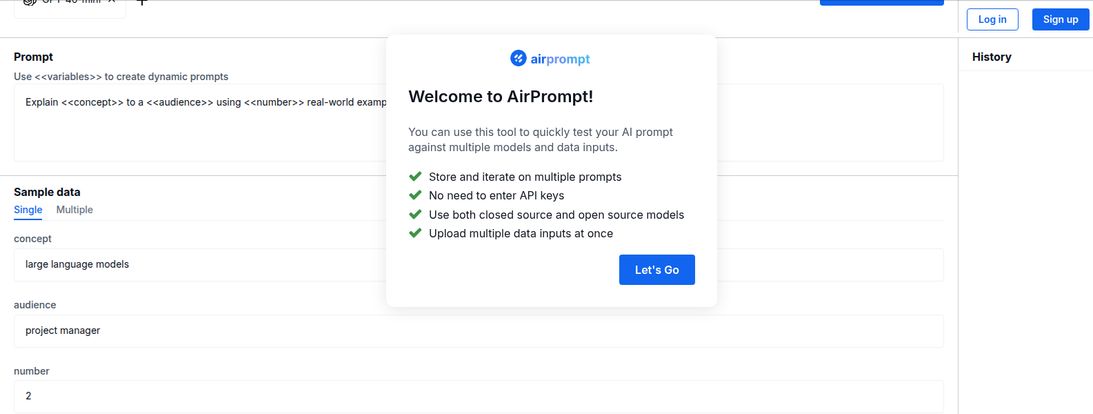We're all living in this wild, chaotic AI gold rush. One minute you're convinced GPT-4 is the answer to everything, the next you're hearing whispers about some new open-source model on Hugging Face that's supposedly a genius at writing code. As an SEO and general marketing nerd, my browser tabs are a constant warzone of different AI chat interfaces. I've got my prompts in a Google Doc, my API keys in a password manager I can never remember the password for, and a growing sense of dread every time I have to copy-paste the same instruction into five different windows just to see which one gets the tone right.
It’s exhausting. It feels less like cutting-edge science and more like digital arts and crafts with a very expensive, unpredictable glue stick.
So, when a tool like AirPrompt pops up on my radar, I'm naturally skeptical but also desperately hopeful. A platform that promises to let you write and test prompts against multiple AI models without all the usual headaches? Sign me up. I’ve spent some time playing around with it, and honestly, I have some thoughts.
So, What Exactly is AirPrompt?
Think of AirPrompt as a universal remote for your AI prompting. Instead of having to go to each AI model’s native website or wrangle with their APIs, you get a single, clean interface. The core idea is simple but powerful: write one prompt, and then test it against a variety of AI models to see which one gives you the best result. But it's a bit more clever than just that. It's built around the idea of creating dynamic, reusable prompt templates. You can create these neat little forms that feed different inputs into your master prompt, letting you generate tons of variations without rewriting a thing. We’re talking unique bedtime stories, personalized sales emails, A/B tested social media posts… you get the idea.
Ditching the API Key Juggle: A Breath of Fresh Air
Okay, this is the part that made me sit up straight. The welcome screen proudly states, “No need to enter API keys.” Let that sink in. For anyone who has fumbled with API documentation, generated keys, set up billing alerts, and then prayed they didn’t accidentally push their secret key to a public GitHub repo (we’ve all had that nightmare), this is a massive deal. It removes one of the biggest barriers to entry for experimenting with different models. Juggling API keys feels like trying to hold onto a handful of wet soap; AirPrompt just gives you a towel. This alone makes it an incredible tool for quick experiments and for people who aren't developers by trade.
The Real Power: Dynamic Prompts and Bulk Data
This is where AirPrompt starts to feel less like a simple playground and more like a professional workshop. The feature set is lean but smart, focusing on things that actually save time.
Getting Creative with Variables
The system uses a simple <<variable>> format. In the tool’s own example, they show a prompt like: “Explain <<concept>> to a <<audience>> using <<number>> real-world examples.” Below this, you get simple text boxes to fill in those variables. You could plug in ‘large language models’ for the concept, ‘project manager’ for the audience, and ‘2’ for the number. Hit go, and the AI does its thing.
Now imagine you’re a marketer. Your variables could be <<product_name>>, <<customer_pain_point>>, and <<call_to_action>>. You can suddenly generate a dozen different Facebook ads in the time it used to take to write one. It’s a simple concept, but the application is incredibly potent.
Uploading Multiple Inputs at Once
And it gets better. AirPrompt supports uploading multiple data inputs. This is basically mail merge for AI. Instead of typing in your variables one by one, you can upload a file (I'm assuming a CSV, though the docs are a bit light) with rows of data. Each row becomes a new set of variables for your prompt. You can generate hundreds of personalized outputs in one click. For a sales team looking to personalize cold emails or an SEO building out meta descriptions for an entire e-commerce category, this isn’t just a time-saver; it’s a complete workflow transformation.
Testing Across the Entire AI Spectrum
Here’s another big win for AirPrompt: it supports both closed-source and open-source models. This is more important than it sounds. While the big players like OpenAI's GPT family are amazing generalists, sometimes you need a specialist. Open-source models are often fine-tuned for specific tasks like coding, creative writing, or maintaining a specific persona. They can also be cheaper to run or offer more privacy.
Having the ability to test your prompt on, say, GPT-4, Claude 3, and an open-source model like Llama 3 side-by-side from one screen is fantastic. You can instantly see which model architecture is best suited for your specific task without all the setup. It’s like having a panel of experts in a room and you get to poll them all at once.

Visit AirPrompt
Who Should Be Using AirPrompt?
After messing around with it, I can see a few groups of people who would absolutely love this.
- SEOs and Content Marketers: This is a no-brainer. Generating blog post outlines, title variations, social media calendars, and ad copy at scale is its bread and butter.
- Sales and Outreach Teams: The ability to create personalized email templates using the dynamic input feature is a game changer for cold outreach.
- Developers and Prompt Engineers: For the serious pros, this is a fantastic environment for A/B testing prompts and comparing model performance without the overhead of building your own testing suite.
- The Curious Hobbyist: Because you don't need API keys, it’s a super accessible way for anyone to play with powerful AI. Want to write a children's story? Go for it. Need a recipe based on ingredients in your fridge? Easy.
The Million-Dollar Question: What's the Price?
So, what does this magic box cost? That's… a bit of a mystery. The information I could find shows no clear pricing plan for AirPrompt itself. I’ve seen some generic pricing pages floating around, but they dont seem to be connected to this specific tool. My gut tells me this means AirPrompt is either very new, in a public beta phase, or perhaps operating on a free-tier model for now to attract users. This is common with new SaaS tools. My advice? Don't trust any third-party sites claiming to have its price list. Go to the source and see for yourself. It might be free to get started, which is a pretty great price if you ask me.
A Few Caveats and Room for Growth
No tool is perfect, especially a new one. The biggest drawback right now is that the full scope of its capabilities isn't totally clear because the content and documentation are a bit limited. It feels like we're only seeing the tip of the iceberg. I'm curious about which specific models are supported, what file types can be uploaded for bulk data, and how the “shareable forms” feature works in practice. But I dont really see this as a con. It’s a sign of a tool in its early stages. The foundation is solid, and there's a ton of potential for growth. I'm actually excited to see what features they add next.
Frequently Asked Questions about AirPrompt
- What is AirPrompt in simple terms?
- It's a web tool that acts as a central hub for testing your AI prompts. You write a prompt once and can test it on multiple AI models to compare the results, all without needing your own API keys.
- Do I seriously not need any API keys?
- That seems to be one of its biggest selling points. By handling the model connections on their end, AirPrompt lets you experiment with different AIs without the technical and financial setup of managing individual keys.
- What kind of AI models does AirPrompt support?
- It supports both closed-source models (like the ones from big tech companies) and open-source models. This gives you a wide range of AIs to test, from powerful all-rounders to specialized, community-built ones.
- Can I use AirPrompt for bulk content creation?
- Yes. Its features for dynamic variables and uploading multiple data inputs at once are specifically designed for generating many variations of a prompt, making it ideal for tasks like personalizing emails or creating social media content at scale.
- Is AirPrompt free?
- The pricing isn't publicly listed yet. This often means the tool is in a free beta period. Your best bet is to visit their site directly to get the most accurate and up-to-date information.
My Final Verdict on AirPrompt
So, is AirPrompt the holy grail of prompt engineering? It's too early to say. But is it a refreshingly simple, cleverly designed tool that solves a very real, very annoying problem for anyone working with AI? Absolutely. The combination of multi-model testing, no-fuss API access, and powerful dynamic inputs makes it a standout tool in a very crowded market.
It’s one of those tools that just makes sense. It's focused, it's practical, and it has the potential to become an indispensable part of my daily workflow. I'm definitely keeping AirPrompt bookmarked, and I'm genuinely excited to watch it grow. If you've been feeling the friction of modern AI workflows, you should probably do the same.
Reference and Sources
The analysis in this article is based on my personal experience using the AirPrompt platform and information publicly available on their website as of this writing. For the latest features and details, please refer directly to the source.
- AirPrompt Official Website (URL not provided)
- General prompt engineering best practices from OpenAI's documentation.



